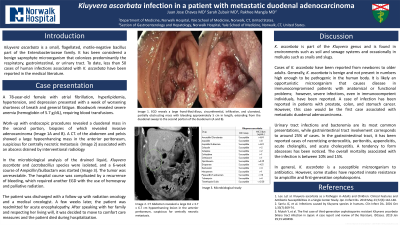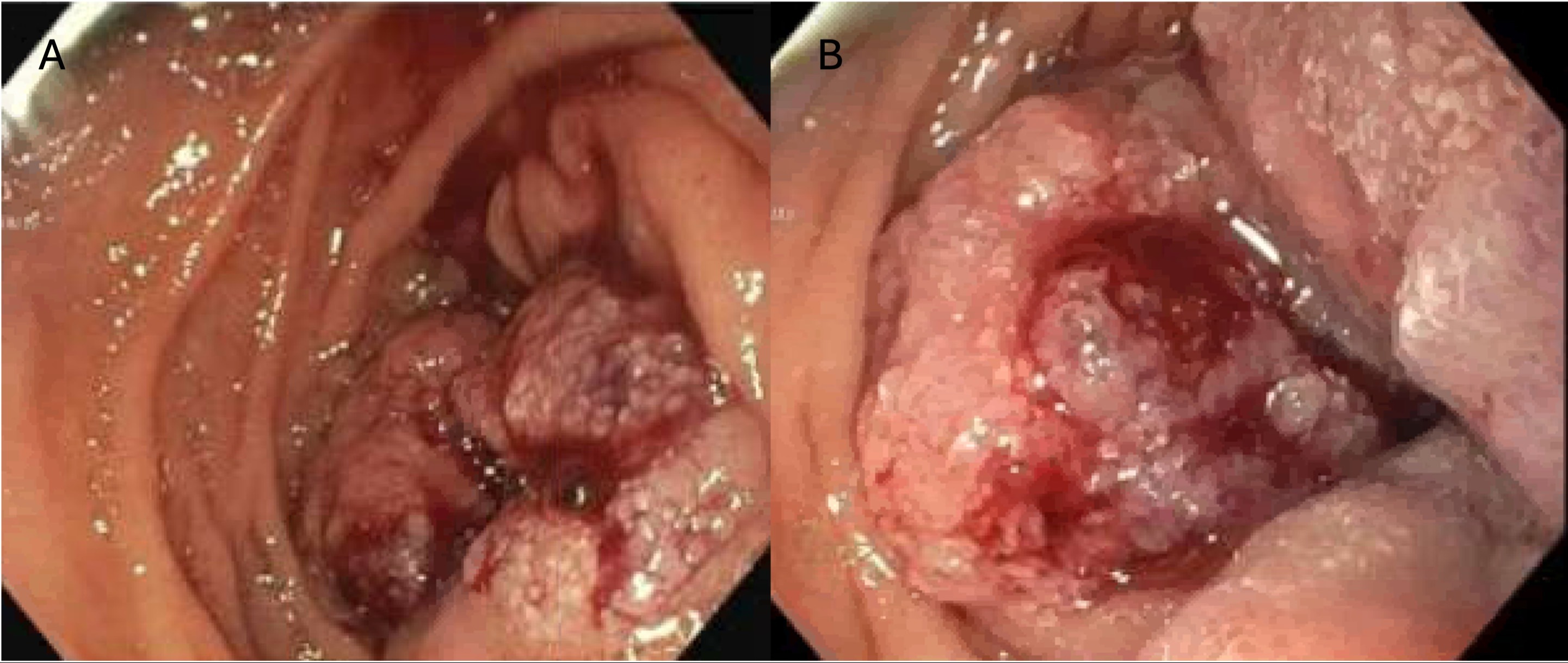Tuesday Poster Session
Category: Small Intestine
P4952 - Kluyvera ascorbata Infection in a Patient With Metastatic Duodenal Adenocarcinoma
Tuesday, October 29, 2024
10:30 AM - 4:00 PM ET
Location: Exhibit Hall E

Has Audio

Juan Jose Chaves, MD
Norwalk Hospital
Norwalk, CT
Presenting Author(s)
Juan Jose Chaves, MD, Sarah Zubair, MD, Rakhee Mangla, MD
Norwalk Hospital, Norwalk, CT
Introduction: Kluyvera ascorbata is a small, flagellated, motile-negative bacillus part of the Enterobacteriaceae family. It has been considered a benign saprophyte microorganism that colonizes predominantly the respiratory, gastrointestinal, or urinary tract. To date, less than 50 cases of human infections associated with K. ascorbata have been reported in the medical literature.
Case Description/Methods: A 78-year-old female with atrial fibrillation, hyperlipidemia, hypertension, and depression presented with a week of worsening shortness of breath and general fatigue. Bloodwork revealed severe anemia (hemoglobin of 5.7 g/dL), requiring blood transfusions. Work-up with endoscopic procedures revealed a duodenal mass in the second portion, biopsies of which revealed invasive adenocarcinoma (Image 1A and B). A CT of the abdomen and pelvis showed a large hypoenhancing mass in the anterior peritoneum, suspicious for centrally necrotic metastasis associated with an abscess, which was drained by interventional radiology. In the microbiological analysis of the drained liquid, Kluyvera ascorbata and Lactobacillus species were isolated, and a 6-week course of Ampicillin/Sulbactam was started. The tumor was unresectable. The hospital course was complicated by a recurrence of bleeding, which required another EGD with the use of hemospray and palliative radiation. The patient was discharged with a follow-up with radiation oncology and a medical oncologist.
Discussion: Cases of K. ascorbata have been reported from newborns to older adults. Urinary tract infections and bacteremia are its most common presentations, while gastrointestinal tract involvement corresponds to around 25% of cases. It is likely an opportunistic microorganism that causes disease in patients in an immunocompromised state with anatomical or functional problems. The overall mortality associated with the infection is between 10-15%. A case of infection has been reported in patients with prostate, colon, and stomach cancer. However, this case would be the first case associated with metastatic duodenal adenocarcinoma.

Disclosures:
Juan Jose Chaves, MD, Sarah Zubair, MD, Rakhee Mangla, MD. P4952 - <i>Kluyvera ascorbata</i> Infection in a Patient With Metastatic Duodenal Adenocarcinoma, ACG 2024 Annual Scientific Meeting Abstracts. Philadelphia, PA: American College of Gastroenterology.
Norwalk Hospital, Norwalk, CT
Introduction: Kluyvera ascorbata is a small, flagellated, motile-negative bacillus part of the Enterobacteriaceae family. It has been considered a benign saprophyte microorganism that colonizes predominantly the respiratory, gastrointestinal, or urinary tract. To date, less than 50 cases of human infections associated with K. ascorbata have been reported in the medical literature.
Case Description/Methods: A 78-year-old female with atrial fibrillation, hyperlipidemia, hypertension, and depression presented with a week of worsening shortness of breath and general fatigue. Bloodwork revealed severe anemia (hemoglobin of 5.7 g/dL), requiring blood transfusions. Work-up with endoscopic procedures revealed a duodenal mass in the second portion, biopsies of which revealed invasive adenocarcinoma (Image 1A and B). A CT of the abdomen and pelvis showed a large hypoenhancing mass in the anterior peritoneum, suspicious for centrally necrotic metastasis associated with an abscess, which was drained by interventional radiology. In the microbiological analysis of the drained liquid, Kluyvera ascorbata and Lactobacillus species were isolated, and a 6-week course of Ampicillin/Sulbactam was started. The tumor was unresectable. The hospital course was complicated by a recurrence of bleeding, which required another EGD with the use of hemospray and palliative radiation. The patient was discharged with a follow-up with radiation oncology and a medical oncologist.
Discussion: Cases of K. ascorbata have been reported from newborns to older adults. Urinary tract infections and bacteremia are its most common presentations, while gastrointestinal tract involvement corresponds to around 25% of cases. It is likely an opportunistic microorganism that causes disease in patients in an immunocompromised state with anatomical or functional problems. The overall mortality associated with the infection is between 10-15%. A case of infection has been reported in patients with prostate, colon, and stomach cancer. However, this case would be the first case associated with metastatic duodenal adenocarcinoma.

Figure: Image 1. EGD reveals a large frond-like/villous, circumferential, infiltrative, and ulcerated, partially obstructing mass with bleeding approximately 5 cm in length, extending from the duodenal sweep to the second portion of the duodenum (A and B).
Disclosures:
Juan Jose Chaves indicated no relevant financial relationships.
Sarah Zubair indicated no relevant financial relationships.
Rakhee Mangla indicated no relevant financial relationships.
Juan Jose Chaves, MD, Sarah Zubair, MD, Rakhee Mangla, MD. P4952 - <i>Kluyvera ascorbata</i> Infection in a Patient With Metastatic Duodenal Adenocarcinoma, ACG 2024 Annual Scientific Meeting Abstracts. Philadelphia, PA: American College of Gastroenterology.
